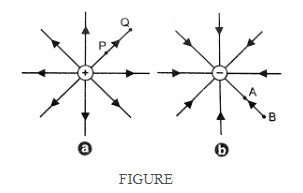Figure shows the field lines of a point negative charge. In going from B to A, the kinetic energy of a small negative charge will

increase
decrease
remain constant
data insufficient
The correct Answer is:B
Due to force of repulsion on the negative charge, velocity decreases and hence the kinetic energy decreases going from B to A .
Topper's Solved these Questions
- ELECTROSTATIC POTENTIAL AND CAPACITANCE BOOK - NCERT FINGERTIPSCHAPTER - ELECTROSTATIC POTENTIAL AND CAPACITANCE EXERCISE - Equipotential Surfaces
9 Videos
- ELECTROSTATIC POTENTIAL AND CAPACITANCE BOOK - NCERT FINGERTIPSCHAPTER - ELECTROSTATIC POTENTIAL AND CAPACITANCE EXERCISE - Potential Energy As A System Of Charges
4 Videos
- ELECTROSTATIC POTENTIAL AND CAPACITANCE BOOK - NCERT FINGERTIPSCHAPTER - ELECTROSTATIC POTENTIAL AND CAPACITANCE EXERCISE - Potential Due To An Electric Dipole
5 Videos
- ELECTROMAGNETIC WAVESBOOK - NCERT FINGERTIPSCHAPTER - ELECTROMAGNETIC WAVESEXERCISE - Assertion And Reason
15 Videos
- MAGNETISM AND MATTER BOOK - NCERT FINGERTIPSCHAPTER - MAGNETISM AND MATTER EXERCISE - Assertion And Reason
15 Videos
Similar Questions
Figure shows the field lines of a point negative charge. In going from B to A, the kinetic energy of a small negative charge will

View SolutionFig (a) and (b) show the field lines of a single positive and negative charges respectively .
Does the kinetic energy of a small negative charge increase or decrease in going from B to A ?

View Solution
Knowledge Check
A body is negatively charged means
AIt has only negative charges.BPositive charges have been neutralized by negative charges.CThe quantity of negative charge present is more than the quantity positive charge present.DThe positive are displaced from their original positions.In the cyanide ion, the formal negative charge is on :
ACBNCboth C and NDresonate between C and NElectric lines of force about negative point charge are
ACircular, anticlockwiseBCircular, clockwiseCRadial, inwardsDRadial , outwards
Figure (a) and (b) show the field lines of a positive and negative point charge respectively.

(a) Give the signs of the potential difference . Vp−VQ,VB−VA
(b) Give the sign of the potential energy difference if a small negative charge is moved from points Q to P from point A to B.
(c) Give the sign of the work done by the field in moving a small positive charge from Q to P.
( d) Give the sign of the work done by the external agency in moving a samall negative charge from B to A .
(e ) Does the kinetic energy of a small negative charge increase or decrease in going from B to A ?
View SolutionFigures (a) and (b) show the field lines of a positive and negative point charge respectively

(a) Give the signs of the potential difference VP−VQ,VB–VA.
(b) Give the sign of the potential energy difference of a small negative charge between the points Q and P, A and B.
(c) Give the sign of the work done by the field in moving a small positive charge from Q to P.
(d) Give the sign of the work done by the external agency in moving a small negative charge from B to A.
(e) Does the kinetic energy of a small negative charge increase or decrease in going from B to A?
View SolutionMetal sol is negatively charged.
View SolutionCan kinetic energy be negative? Explain.
View SolutionA body can be negatively charged by
View Solution
